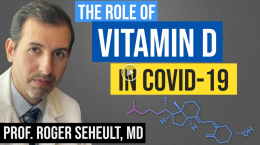Published on September 29, 2021
Video Friday: To kick off Breast Cancer PREVENTION Month, we share this video by our director, Carole Baggerly, about her breast cancer story turned inspiration
Key Points
- An estimated 67-70% of breast cancer could be prevented by achieving a vitamin D level of at least 40-60 ng/ml; in fact, women with vitamin D levels at or above 60 ng/ml (150 nmol/L) had an 80% lower breast cancer risk compared to women with levels less than 20 ng/ml (50 nmol/L)
- GrassrootsHealth and D*action were started after director Carole Baggerly’s experience with breast cancer and its treatment – watch the video to hear her story!
- D*action is about more than just testing vitamin D levels; it is about participating to improve vitamin D levels for ALL through measurement, education, action, research, and most importantly, spreading the word!
 “By following the recommendations made by our scientists panel, it is estimated that we could have an annual 67-70% reduction in incidence of breast cancer, as well as type 1 diabetes, multiple sclerosis, colon cancer… within only 5 years!”
“By following the recommendations made by our scientists panel, it is estimated that we could have an annual 67-70% reduction in incidence of breast cancer, as well as type 1 diabetes, multiple sclerosis, colon cancer… within only 5 years!”
October is Breast Cancer Awareness Month, which we would rather refer to as Breast Cancer PREVENTION Month. Throughout the month we will be presenting information on vitamin D and other nutrients that have been linked to a reduction in breast cancer incidence and recurrence – since, after all, the best medicine is safe, effective PREVENTION!
To kick off the month, please tune in to the video below, which features our Director, Carole Baggerly, and our Principle Investigator, Dr. Cedric Garland. This video will be featured as Part 1 (with Carole) and Part 2 (with Dr. Garland), but feel free to watch it all at once!
Vitamin D Can Help Prevent Breast Cancer – Is It True? (Part 1)
Carole’s Breast Cancer Turned D*action Story: The motivation behind the beginning of D*action
For anyone who has cancer, has had cancer, or knows anyone who has or had cancer – please share this story and information.
Carole Baggerly was diagnosed with breast cancer in 2005. As she describes it, the cancer was bad enough, but then, she had the treatment for cancer. She had a mastectomy, chemotherapy (which permanently damaged some of her body), and radiation (until she bled), and all of that led her to an intense desire to find a better way to address breast cancer.
Through her research and the research of the scientists she met in the months that followed, she found a way to address it – through prevention.
Carole was invited to attend a two day seminar in May of 2007, sponsored by the National Cancer Institute, with researchers from all over the world presenting what they knew about vitamin D and cancer. So much was already known about vitamin D and cancer! Yet what were they going to do with the information? What was the researchers’ response to how they were going to get the message out?
Carole immediately realized that, while these researchers had spectacular scientific knowledge about the role of vitamin D in cancer prevention, their message would fail to get out without a dedicated “sales” team!
She then spent the next three months travelling the United States and Canada to visit vitamin D researchers with the goal of creating a defined message about vitamin D. Unfortunately, the question that is often asked, “What dose should I take?” was the wrong question to be answering and would therefore lead to the wrong message… since someone’s dose depends on several different factors and varies widely from person to person.
Based on a consensus from a panel of now 48 respected vitamin D scientists from around the world, the key message about vitamin D remains the same as it was first defined at the start of D*action – the 25(OH) vitamin D level in the blood should be 40-60 ng/ml (100-150 nmol/L), and given that, the correct dose can be determined.
With this as the core message, D*action was born to help get the message out, to give access to many individuals who did not have a way to test their vitamin D level at the time, and to further define the health outcomes related to a level within the 40-60 ng/ml range.
Key Points to Get Across with the D*action Project
- what is the “natural” vitamin D level – where does the 40-60 ng/ml (100-150 nmol/L) come from?
- levels below 40-60 ng/ml are not adequate or “normal”
- people in the northern latitudes taking 4000 IU per day only reached an average level of 32-34 ng/ml (80-85 nmol/L) – many still need more! But how do you know if you do need more? Measure your level, which you can do through D*action.
- the Disease Incidence Prevention Chart shows a list of diseases that could be reduced upon reaching target levels of vitamin D. For example, one study showed a 35% reduction in all cancers upon reaching a vitamin D level of 38 ng/ml (95 nmol/L)… newer studies show an even greater reduction with vitamin D levels above 60 ng/ml… this is primary prevention!
- concerned about toxicity? Read this
- “We would have a changed country” if everyone got their vitamin D levels up… discover more of the research showing the benefits of vitamin D and other nutrients for different diseases and health outcomes on the GrassrootsHealth blog
Something Non-Toxic and Inexpensive Can Really, Truly Help Prevent Cancer!
LOTS of studies show the same thing… it is clear that the issue with breast cancer is directly related to vitamin D
Continue watching the video to learn about vitamin D from Dr. Cedric Garland, and hear about the initial findings from the D*action study, or wait for the summary in Part 2 coming soon!
What is D*action?
D*action started out as a 5 year (now on-going) public health project to provide education and research to SOLVE the vitamin D deficiency epidemic, by measuring vitamin D serum levels, collecting health data from participants, and tracking the health effects of getting to levels of 40-60 ng/ml (100-150 nmol/L).
Take action now! We know enough to reduce diseases today.
- Measure your vitamin D level (sign up and participate in the study)
- Adjust your level (through supplementation, co-nutrients, sun, food)
- Re-test to see if you’ve achieved your target
- Spread the word to everyone you know!
Learn more about what is involved in participation, additional discoveries that have been made using participant data and results, other top areas of interest in further data analysis and findings, and new standards of care that have been implemented into medical practice due to what we already know about vitamin D!
Order Your Kit to Participate Today
 Having and maintaining healthy vitamin D levels and other nutrient levels can help improve your health now and for your future. Choose which to measure, such as your vitamin D, omega-3s, and essential minerals including magnesium and zinc, by creating your custom home test kit today. Take steps to improve the status of each of these measurements to benefit your overall health. You can also track your own intakes, symptoms and results to see what works best for YOU.
Having and maintaining healthy vitamin D levels and other nutrient levels can help improve your health now and for your future. Choose which to measure, such as your vitamin D, omega-3s, and essential minerals including magnesium and zinc, by creating your custom home test kit today. Take steps to improve the status of each of these measurements to benefit your overall health. You can also track your own intakes, symptoms and results to see what works best for YOU.
Enroll and test your levels today, learn what steps to take to improve your status of vitamin D (see below) and other nutrients and blood markers, and take action! By enrolling in the GrassrootsHealth projects, you are not only contributing valuable information to everyone, you are also gaining knowledge about how you could improve your own health through measuring and tracking your nutrient status, and educating yourself on how to improve it.
Help everyone Move Research into Practice with vitamin D and other nutrients! As a special birthday gift to everyone, in honor of the science, we have created a special scholarship fund for anyone to donate to that will go towards helping others participate. Your donation will allow anyone to get help with funding their participation when they need it.
Text-to-give: Text Daction to 44321 to add to our Scholarship Fund.





